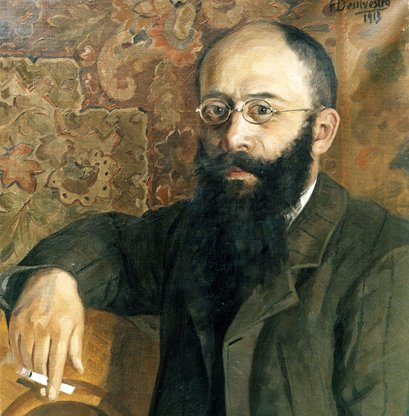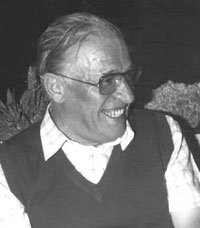The
Fanes' saga - Researches on the legend
A
short history of the studies on the legend
|
The
Ladinians
They
are the original inhabitants of the Dolomites. Pinched between
Italians and Germans, they number today about thirty-five thousand
people. They speak a neo-latin language, likewise named Ladinian,
that is subdivided into as many dialects as there are valleys,
but closely resembles Friulian and Grisons’ Romansch.
The three languages must once have been a single one, widespread
all over central and eastern Alps.
The
Ladinians’ DNA is very different from that of their neighbours’,
but they are highly differentiated among themselves also, therefore
representing a riddle for geneticists. They are known to descend
from a population, named Rhaetians by the Romans, that endured
several Celtic and Latin infiltrations even before the early
Middle Ages, when it was wedged and divided by Franks, Bavarians,
Slavs and so on.
Although
deeply attached to their language and their traditions, the
Ladinians have long been at risk of losing both, squeezed as
they were between two mighty cultures like the Italian and the
German ones, on the verge of even giving up the pride of their
national identity. Only at the end of the nineteenth century,
in the age of nationalisms, a few people started recovering
and revamping the ancient traditions, of which the legends represented
an essential part.
Orally
handed down one generation to the next, in an environment where
writing was almost inexistent, at most limited to official acts
compiled in a foreign language, legends had long been preserved
almost intact. Although regarded with hostility by the Counter-reformed
church, they really declined only when literacy began to replace
the oral tradition as a cultural standard; at the end of the
nineteenth century the tradition-preserving community had almost
vanished and just a few old men remembered scattered, generally
short fragments of what once had been a rich and compact corpus.
We must remind, among the first who gave impulse to the wearisome
revitalization of the ancient legends, don Giuseppe Brunel and
Tita Cassan from the Fassa valley and Wilhelm Moroder-Lusenberg
from the Gardena valley. We shall examine now the most significant
authors in some more detail.
|
Hugo
de Rossi
Ugo
or Hugo de Rossi or Hugo von Rossi [de Santa Juliana] (1875-1940)
was born in the Fassa valley, lost one arm in the first World War
and lived at Innsbruck since then to his death. In 1912 he collected
his “Tales and Legends of the Fassa valley – 1st
Part”, published today, in both German-Ladinian and
Italian-Ladinian versions, by the Istitut Cultural Ladin "majon
di fashegn" of Vigo di Fassa (1984, edited by Ulrike
Kindl). Unfortunately, the second part never followed, as
it should according to the Author’s intentions. It was expected
to contain a lot of fresh material relevant to the so-called “Trilogy
of Fassa”, compiled by Wolff.
A
honest and careful scholar of folklore, although he didn’t
consider himself as an expert, de Rossi transcribed everything
that people reported him, not allowing himself to introduce variations
and taking diligent notice of the variants he possibly discovered.
His collection is of the utmost importance for, among others,
the traditions connected with the pre-roman Fassa, with the Roman
conquest, with the anguane and the salvani (i.e. wildmen); Wolff
himself, who was in touch with him, derived several themes from
him. Unfortunately for our purposes, the passages directly dealing
with the Kingdom of Fanes are very few and of little relevance.
|

|
Karl
Felix Wolff
He
was born in 1879 at Karlstadt, today Karlovac in Croatia, son
of an Austrian officer and Lucilla von Busetti, a woman from
the val di Non. His family moved to Bolzano when he still was
a little boy. There, Wolff listened to his first Ladinian legends,
narrated by an aged nanny from the val di Fassa. Later on he
got in touch with some Ladinians who strived to get their language
and their traditions back into use: Cassan, de
Rossi, Moroder-Lusenberg. He became a journalist and a writer,
but never stopped wandering all over the Dolomites, his pocketbook
at hand, questioning common people, specially the most aged,
in the hope that they could convey him a new legend or a new
detail. At first his interest was mostly focused on the closer
and more familiar Fassa valley, but later on he extended the
range of his researches to all other Dolomitic valleys, pushing
as far as Cadore and Alpago. He died at Bolzano in 1966.
He
published the results of his research stepwise, until he had
composed a trilogy: I monti pallidi (The Pale Mountains); L'anima
delle Dolomiti (The Soul of the Dolomites); Rododendri bianchi
delle Dolomiti (White alpine roses from the Dolomites). His
books appeared in several editions, at times with different
titles, over a wide time span. They are available today in the
edition by Cappelli (Bologna), in their Italian translation,
and by Athesia (Bolzano), in the German original. Wolff additionally
published a wide number of articles on several different magazines,
as well as many booklets and leaflets. People interested in
his complete bibliography can find it in Ulrike
Kindl (1983): Kritische Lektüre der Dolomitensagen
von Karl Felix Wolff, Band I: Einzelsagen, Istitut
Cultural Ladin "Micurá de Rü", San
Martin de Tor.
The
importance of Wolff’s work for the rescue and revitalization
of the ancient Ladinian legends can hardly be overestimated.
There are good chances that, had it not been for him, today
we would know close to nothing about the Fanes. Unfortunately,
however, Wolff’ methods were not as rigorous as they should,
and he didn’t care recording what he had collected exactly
the way it had been narrated to him. His position was that of
a writer and a poet (and maybe, as a highly cultured man, a
good Austrian and a germanophile, he also felt a little superior
as well); therefore in good faith he made his best to restore
and refurbish, and allowed himself to twist the story a little
bit, sometimes even to insert a few missing pieces, in order
to obtain (inconsciously?) that the result might look a little
closer to the general picture he had in his mind. His
hand is usually visible, and therefore the “restored”
parts can easily be removed, but we are often left in doubt
whether something not completely understood or not completely
original may remain unaccounted for.
|

|
| |
| |
Karl
Staudacher
Son
of an hotel owner of Brunico, Karl Staudacher (1875-1944) when
still a small boy listened to the tales of the Fanes’ kingdom,
recounted by girls from the val Badia who had a job at his father’s.
Having demonstrated a great talent for studying, he became a priest
and worked in several parishes; never, unfortunately, in areas
that might allow him to collect additional material on the Fanes.
In 1921 he got in touch with Karl Felix Wolff,
to whom he made available several fundamental elements that were
known in the val Badia but not in Fassa, and lie at the very root
of the legend (marmots, vultures, twinnings…). Alas, he
was no anthropology student, and even no folklore lover: the Fanes
interested him primarily as Nibelungians’ epigones. In effect,
he left us a boresome epic poem, written in perfect German verses,
Das Fanneslied (1928: available by Tyrolia, Innsbruck-Wien 1994).
In his poem, Staudacher almost punctually conforms to the plot
of the story as reconstructed by Wolff, although
he sometimes deviates into shocking directions, often according
to ethymological interpretations which look both daring and naïve.
(As an instance, he derives Duranni from Thyrrenoi,
accordingly identifying them with the Etruscans and locating Ey-de-Net’s
home close to Florence; at the same time he identifies the Caiutes
with the Celts – whose kingdom’s capital town was
Brescia!).
|

K.
Staudacher as painted by J.B.Oberkofler
(from Das
Fanneslied, Tyrolia ed.)
|
Angel
Morlang
Angel
Morlang (1918-2005) was born at Pieve di Marebbe and spent his
whole life in the Ladinian valleys. Like Staudacher,
he took orders as a priest. He had several interests; for instance,
he also was a good painter. In 1951 he published, in the Ladinian
dialect from Marebbe, “Fanes da Zacan”
(Fanes of Old), reprinted by the Istitut Ladin "Micurá
de Rü" of San Martin de Tor in 1978.
His
text was written as a script for an open-air popular drama,
what Wolff (who greeted it enthusiastically)
had long been longing for. As a matter of fact, it was repeatedly
performed at La Valle and San Vigilio di Marebbe. Morlang substantially
follows Wolff’s version, however
with a few noteworthy exceptions (e.g. Spina-de-Müsc
instead of Spina-de-Mul, the vulture taking back his
place usurped by the eagle…). A few differences can merely
be connected with staging requirements, while others may hint
at an effectively different tradition from the val Badia (e.g.
the single campaign from the Pralongià to the
Furcia dai Fers), and others are probably just a good
Christian’s misreadings, like Dolasilla buried
by Ey-de-Net. The mountain priest’s moralistic lectures
are regrettably well visible and abundantly strewn.
|

|
Modern
Critics
Wolff
apart (who perceived their importance, but never got a full
and clear picture), as far as I know, the first to understand
the anthropological implications of the Fanes’ saga was
Kläre French-Wieser, who in 1974 published
an article, “The Fanes’ Kingdom – A Matriarchate
Tragedy” on the Bolzano magazine “Der Schlern”.
The
most significant scholar in modern studies about de
Rossi, Wolff and their collections
is anyway Ulrike Kindl. She teaches German
language and literature at the University of Venice and masters
all three languages, Ladinian, German and Italian. She edited
both de Rossi’s collection of tales
and legends (1984) and the symposium held in 1985 at Vigo di
Fassa on the same subject. She certainly is the top leading
authority about Dolomitic legends. She is the author of several
books, among which both Kritische Lektüre der Dolomitensagen
von Karl Felix Wolff, Band I: Einzelsagen (1983) and Kritische
Lektüre der Dolomitensagen von Karl Felix Wolff, Band II:
Sagenzyklen (1997), where she thoroughly analyzes Wolff’s
complete literary production and expounds it with great depth
of thought.
Professor
Giuliano Palmieri,
from Treviso (1940-2007), is the author of several archaeological
researches. He wrote together with Marco, his son, I regni
perduti dei Monti Pallidi (“The lost Kingdoms of
the Pale Mountains”) (1996), where he ingeniously probed
into several aspects of the Ladinian legends, specifically investigating
several details of the Fanes’ Kingdom. He later
on published Le antiche voci dei Monti Pallidi (“The
ancient voices from the Pale Mountains”), mostly devoted
to different topics, of great cultural and anthropological interest,
but where one can also find several themes strictly connected
with the legends collected by Wolff.
In
the year 2000, Helmut Birkhan, an Austrian
professor from the University of Wien, published an essay at
the meeting "AD GREDINE FORESTUM 999-1999". After
comparing the Fanes' saga with other ancient European legends,
he tries a "historical" approach to the interpretation
of the legend, without pushing into much detail, and concludes
by accepting the authenticity and antiquity of the "anthropological"
core of the saga.
One
year later, Veronica Irsara, from San Cassiano,
took her degree discussing a thesis about the Fanes. She establishes
an original compromise between prof. Kindl's "subjective
method" and prof. Palmieri's "objective" one.
|
|

